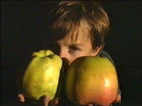 |
HOME lescrets fruits et pomologie Site personnel d'information à caractère non commercial et gratuit - Free personal site of information to non commercial character |
|||||
GREFFER LES ARBRES FRUITIERS
Grafting fruit trees
Time to graft Relation stock/scion Grafting wax
shield budding Whip-Grafting Cleft Grafting
Whip Grafting
Root-grafting. The West seems to prefer trees that are root-grafted, some sections preferring piece roots, others whole roots.
The seedlings which are to be grafted are treated in two ways. The more common way is to cut off the tops at the crown, and to cut each root into two or three pieces from 2 to 4 inches long, according to the diameter and length of the root. A scion is then grafted into each piece by the whip-grafting method. This is called a piece-root graft and the tree grown from it a piece-root tree. A second way is to put one scion into the crown of each seedling root, which is not cut except to shorten the side roots and the extreme tip. This is a whole-root graft, and will make a whole-root tree.
In order to determine the advantages of each system of rootgrafting, experiments were carried out by many state experiment stations. These showed that in their early life whole-root trees do better than piece-root trees, but that later there is little difference.
Both whole-root and piece-root grafted trees are usually cut down to the ground at the end of the first year, and start out the following spring on equal terms as regards the size of the top. The piece-root graft has made many new roots during the first year, and a difference in growth between the two during the second

FIG. 179. Whip-grafting
year is seldom noticeable. The disparity between the two grows constantly less as the trees get older. After three or four years one can rarely detect the difference between them in vigor or size.
The length of the scion used in root-grafting is thought to make some difference; however, experiments carried on at the Kansas Station have clearly shown that for practical purposes the length of the scion is of minor importance, but that a length of from 6 to 9 inches is preferable.
Comparison of budding and root-grafting. Practice and experiments have fully demonstrated that, so far as the method of propagation is concerned, there is absolutely no difference in the
value of root-grafted and budded trees. It has been proved beyond any question that orchards of root-grafted trees are as uniformly vigorous, productive, and long-lived as orchards of budded trees. An unbiased examination of the older orchards of the East and West should convince one of this fact.
Whip-grafting. This process is to cut the tree on a slant or angle and not straight across. The scion is cut in a like manner. With a sharp knife the cut is made with one stroke. A tongue is made on each slanting cut of both stock and scion by slightly pushing the knife into the wood. The scion is then placed on the stock, cut surface against cut surface, and the tongues lapped so that they hold the scion in place.
It is important to have the cut of both scion and stock similar, and to have the cambium layer of the scion coincide with the corresponding layer on the stock either entirely, where the stock and scion are the same size, or partly, where the stock is larger than the scion. Sometimes it may help to tie the scion to the stock with raffia or twine, but this should be removed soon after a union is made.
Whip-grafting is sometimes used in top-working trees, as well as in root-grafting. The operation generally takes place in the spring.